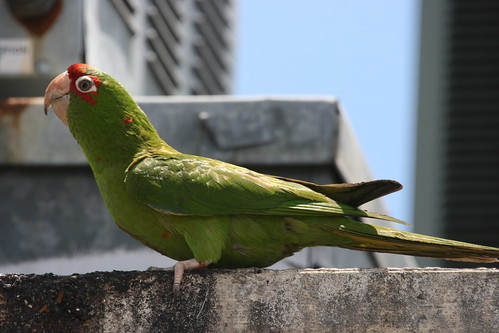 Mitred parakeet drinking at a rooftop, Miami Springs, FLA couple of weeks back, I got an e-mail from a reader suggesting a column about the Berkeley parrot flock. In trying to pull that column together, I was struck by how little I knew about these birds—in contrast to their celebrity cousins in San Francisco.
Mitred parakeet drinking at a rooftop, Miami Springs, FLA couple of weeks back, I got an e-mail from a reader suggesting a column about the Berkeley parrot flock. In trying to pull that column together, I was struck by how little I knew about these birds—in contrast to their celebrity cousins in San Francisco.
I do know that there have been free-range parrots in the Berkeley-Albany borderlands since at least the late 1970s or early 1980s, when they used to visit the fruit trees of a friend on Kains Street. Their numbers appear to be much diminished and I’ve had years go by without a sighting, but it appears that a few survivors are still out there.
And I’m reasonably sure that their species is Aratinga mitrata, the bird known to ornithologists and birders as the mitred parakeet and to aviculturists as the mitred conure. There’s a deep linguistic divide here. Parrot fanciers use “conure” for several genera of New World psittacines, smaller than macaws and larger than budgies, with long pointed tails and strident voices even for parrots. The American Ornithologists’ Union, the American Birding Association, and the California Parrot Project call them “parakeets.”
The two camps sometimes use different specific names: the Telegraph Hill birds are either cherry-headed conures or red-masked parakeets, depending. (Except that the authoritative Parrots of the World, by Tony Juniper and Mike Parr, uses “red-masked conure.” Go figure.)
For years I wasn’t sure what the Berkeley parrots were; in the ’80s, exotic parrots weren’t depicted in the standard bird guides. Now so many species have become naturalized in the United States, mostly in Florida and southern California, that the current editions of the National Geographic, Sibley, and Peterson guides have better coverage. I suspected they were mitred, and a recent image I found on Flickr supports this: the two Berkeley parrots in the photo have red foreheads and cheeks and green crowns (a pattern that reminded someone of a bishop’s headgear) as opposed to the more extensive red of the red-masked. Outside San Francisco, the mitred seems to be the more common of the two in California.
Mitred and red-masked parakeets are closely related, though, and have been known to interbreed in the urban wilds. A mitred parakeet joined the San Francisco flock and made a significant contribution to its gene pool.
So let’s say the Berkeley birds are mitred. That means the founders of the flock likely came from Bolivia, the source of most captives according to Parr and Juniper. The overall range extends from southern Peru to northern Argentina, although a couple of the Peruvian populations may be distinct species. Mitred parakeets mainly inhabit dry subtropical vegetation, often near cliffs, but have been observed in other habitats including cloud-forest, dry savannas, and farmlands. Although most populations are resident, some have seasonal movements.
Like almost all psittacines, mitred parakeets are cavity nesters, using hollows in trees or rock faces. (The monk parakeet, native to South America but naturalized from Florida to Chicago, is the great exception: monks build large untidy communal stick nests, often on light poles and other man-made structures.) They’re fruit eaters but have been known to raid grainfields. Flock size ranges from two or three up to 100. The population in the wild appears to be stable.
According to the California Parrot Project (mostly L.A.-centric, which is after all where the parrots are), the mitred has made itself at home in coastal areas from Malibu to Long Beach and northwestern Orange County, and in the Los Angeles Basin and San Gabriel Valley. The birds have enjoyed a recent population boom: Southern California numbers are estimated as around 1,000, not counting San Diego, and there are additional flocks in Sacramento and Sunnyvale.
But the Berkeley flock may be on its way out. When I interviewed San Francisco parrot patron Mark Bittner a couple of years ago, he recalled being told that someone had been trapping the Berkeley birds. Although mitred parakeets seem hardy, some may have succumbed to our colder winters. The most recent report I was able to find in Mount Diablo Audubon’s archive of East Bay bird sightings was of four near West Berkeley’s James Kenney Park in September 2006.
I’m hoping some readers have been keeping a closer eye on the flock than I have, and will be able to help fill out this sketchy portrait. Does anyone else recall the larger flock? Were they all mitred, or were other Aratinga species mixed in? Where do they nest—in hollow trees? On buildings? Is there a favorite roost? (I remember seeing them around St. Ambrose’s on Gilman late in the afternoon.) What do they eat? Has anyone—an unsung Berkeley Bittner—been feeding them?
If you have any information—not excluding legends or rumors—please send it to the Planet, for a future update.